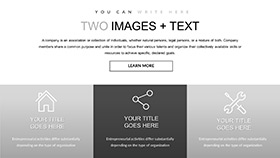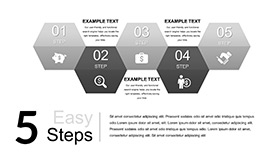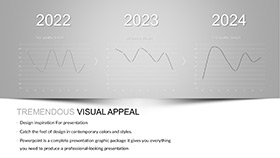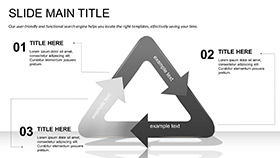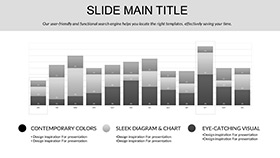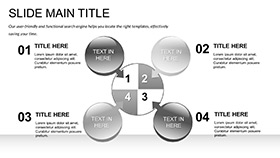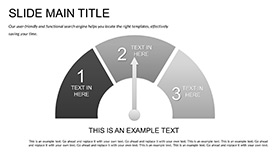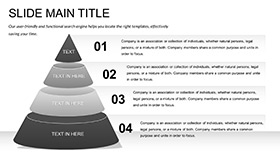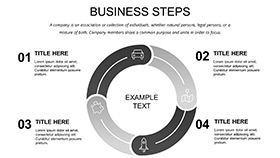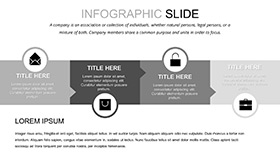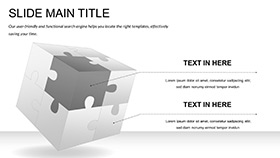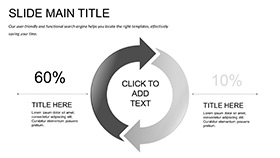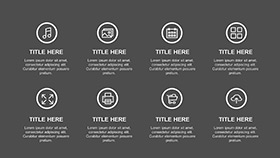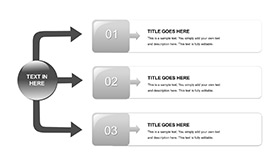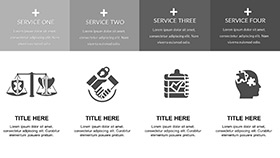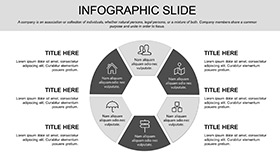Imagine transforming complex lab data into visuals that not only inform but inspire curiosity about the microscopic world. The Laboratory Microbiology Keynote Template is crafted for scientists, educators, and biotech professionals who need to convey intricate biological processes with clarity and elegance. With 28 ready-to-use diagram slides, three master layouts, and three background options across seven versatile color schemes, this template turns raw research into compelling narratives. Whether you're preparing a lecture on bacterial cultures or a report on viral pathways, these slides adapt seamlessly to your content, saving hours of design time while ensuring your message resonates.
At its core, this template addresses the challenge of making dense scientific information accessible. Picture a slide where a multi-step experiment unfolds in a clean flowchart, or a comparison of microbial strains laid out in an intuitive Venn diagram. Built for Keynote's robust editing tools, every element - from icons of petri dishes to animated transitions - responds intuitively to your tweaks. Professionals in pharma labs or university settings have long relied on such structured visuals to bridge the gap between lab benches and boardrooms, much like how leading biology texts use diagrams to demystify cellular mechanics.
Unlocking the Template's Core Features
Dive deeper into what makes this template a standout for microbiology enthusiasts. Starting with the three master slides, you get foundational structures that dictate the overall flow: one for title intros with subtle lab-themed gradients, another for data-heavy content blocks, and a third for summary conclusions with callout accents. Pair these with the three backgrounds - a sterile white for clinical precision, a soft blue evoking sterile environments, and a neutral gray for versatile projections - and you've got a canvas that fits any venue, from dim lecture halls to bright conference screens.
The real power lies in the 28 diagram slides, each engineered for specific microbiological applications. For instance, slide 1 introduces a circular process diagram perfect for outlining the stages of microbial fermentation, complete with editable segments that highlight key variables like temperature or pH levels. Move to slide 7, a layered pyramid chart that breaks down ecosystem interactions in soil bacteria, allowing you to stack elements for emphasis on symbiotic relationships. These aren't static images; they're vector-based, so resizing or recoloring via Keynote's inspector panel maintains crisp quality, even on 4K displays.
- Seven Color Schemes: From vibrant greens symbolizing growth to muted earth tones for environmental studies, switch palettes to match your branding or data themes without starting from scratch.
- Multifunctional Infographics: Icons of microscopes, DNA helices, and culture tubes integrate effortlessly, pulling from Keynote's shape library for further customization.
- Animation-Ready Elements: Subtle builds reveal data points sequentially, mimicking the step-by-step nature of lab protocols.
Customization is straightforward: select a slide, drag in your photos from iPhoto integration, and adjust text kerning for that polished academic look. This template shines in workflows where time is tight - think grant proposal deadlines or impromptu team huddles - by providing placeholders that guide your content placement intuitively.
Real-World Applications: From Classroom to Conference
Envision a university professor using slide 14's timeline diagram to trace the evolution of antibiotic resistance, plotting milestones with drag-and-drop markers that align perfectly with Keynote's smart guides. The result? A dynamic lecture that keeps students engaged, far surpassing clunky bullet lists. Or consider a biotech startup pitching to investors: slide 22's SWOT analysis matrix, adapted with lab-specific quadrants for strengths like proprietary strains, helps articulate risks and opportunities in a glanceable format.
For hands-on users, here's a quick workflow to integrate this template into your next project:
- Import and Setup: Open in Keynote, choose your master slide, and apply a background that complements your venue's lighting.
- Populate Data: Use slide 5's bar graph for quantitative results - link to Excel via copy-paste for live updates if needed.
- Enhance with Media: Embed a short video of a microscopy clip on slide 10's media frame, ensuring smooth playback on Apple Silicon devices.
- Refine and Export: Animate transitions for flow, then export as PDF for handouts or video for social sharing.
In consulting scenarios, like advising on lab compliance, slide 18's mind map connects regulatory nodes to procedural branches, fostering discussions that lead to actionable insights. This template's flexibility extends to hybrid events too - its lightweight file size (under 10MB) ensures quick loads on cloud-synced iPads for remote collaborators.
Detailed Slide Spotlight: Building Your Narrative
Each of the 28 slides serves a distinct purpose, creating a modular toolkit. Slide 3's radial chart dissects enzyme reactions, with spokes that expand on hover for deeper dives during Q&A. Slide 11 contrasts methodologies in a dual-axis line graph, ideal for debating wet vs. dry lab techniques. Further along, slide 25's infographic timeline chronicles discovery milestones, from Pasteur's pasteurization to CRISPR breakthroughs, with timeline beads that hyperlink to source notes.
Practical tip: For color-blind audiences, leverage the high-contrast schemes and add alt text to images via Keynote's accessibility tools - slide 20's photo placeholder for gel electrophoresis bands becomes a descriptive asset. Compared to building from blank slides, this template cuts iteration cycles, letting you focus on science over styling. Users in fields like environmental microbiology appreciate how slide 26's geographic map overlays pollution data, turning global stats into localized stories.
Integrate with other tools by exporting charts to Numbers for advanced calculations, then reimport for seamless synergy. The endgame? Presentations that not only inform but provoke thought, much like a well-designed experiment sparks hypotheses.
Why This Template Transforms Your Lab Communications
Beyond aesthetics, this template empowers confident delivery. Its balanced whitespace prevents overload, guiding eyes to focal points like yield curves on slide 9's scatter plot. For educators, the editable notes pane in Keynote lets you script speaker cues per slide, ensuring smooth pacing. In business contexts, such as pharma sales demos, the professional polish rivals agency work, positioning you as a thought leader.
Ready to infuse your next microbiology deck with precision and poise? Download the Laboratory Microbiology Keynote Template today for $22 and watch your ideas culture into unforgettable presentations.
Frequently Asked Questions
What software versions does this template support?
This template is fully compatible with Keynote 2016 and later versions, including the latest macOS releases.
How many customization options are available?
With seven color schemes, three masters, and three backgrounds, you have extensive options to tailor the look to your needs.
Can I add my own images to the slides?
Yes, all placeholders support drag-and-drop image insertion, with automatic resizing to maintain layout integrity.
Is the template suitable for non-scientific presentations?
While optimized for microbiology, its diagrams adapt well to general data visualization in education or business.
What file formats are included?
You receive .key and .kth files for easy opening and theme application in Keynote.









